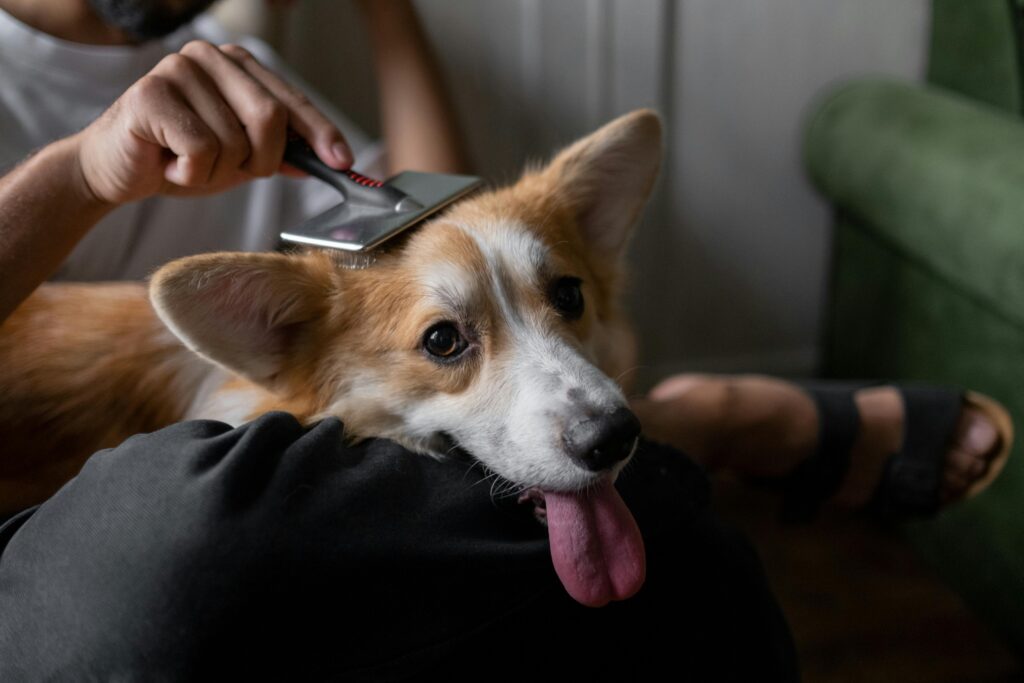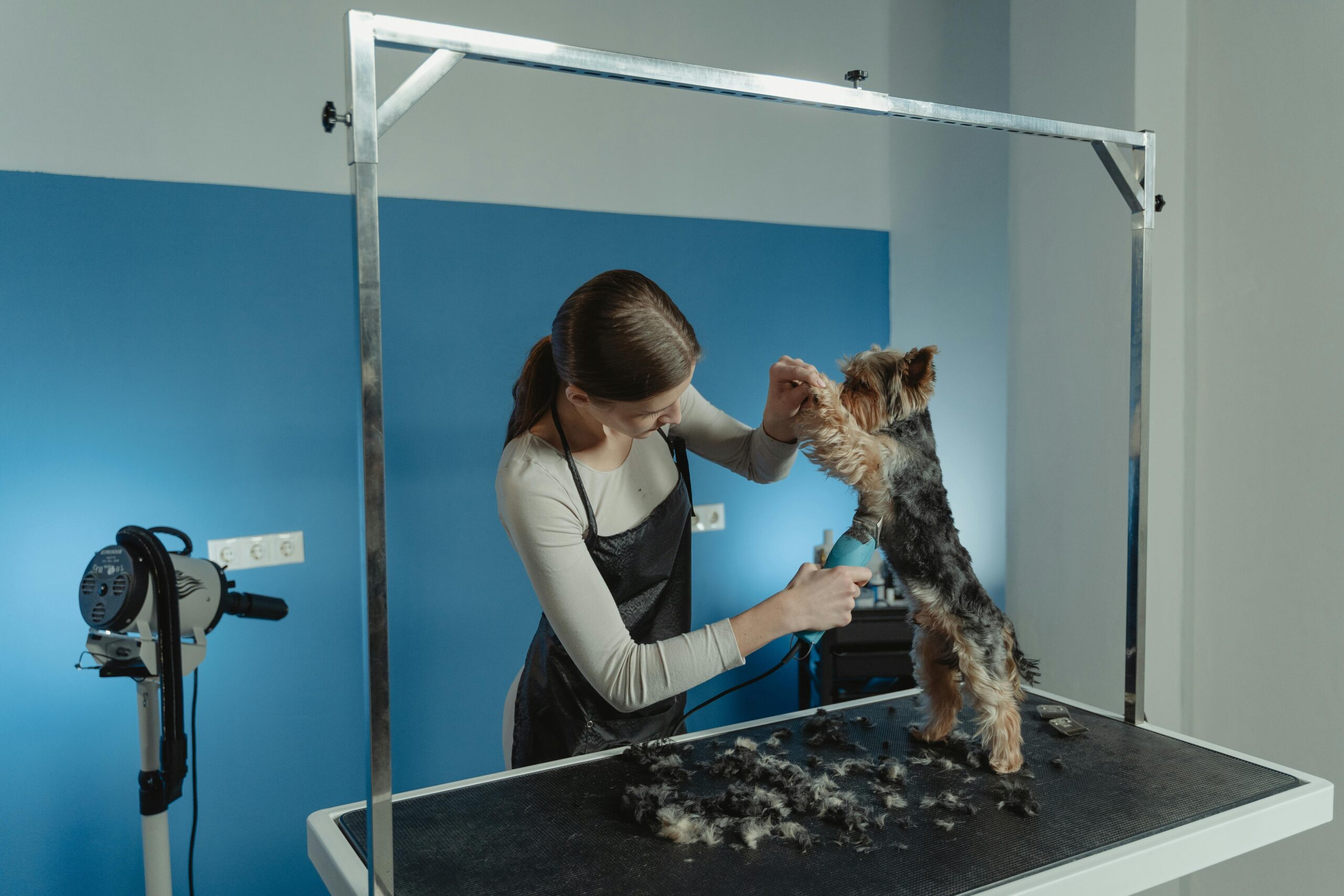Caring for your animal friends goes beyond just feeding and playing with them; grooming is vital for their health. Having the correct pet grooming tools at home will save you time, money, and the stress of regular salon visits, whether your pet is a dog, cat, rabbit, or even guinea pig. Emphasizing utility, simplicity of use, and cost, this guide investigates the finest pet grooming tools for household usage.

Why Grooming Your Pet at Home is Important
Strengthens Your Bond
Grooming guarantees your pet feels cherished and offers an opportunity to spend quality time with them, so deepening your bond.
Improves Hygiene and Health
Frequent grooming keeps your pet healthy and happy by lowering shedding, avoiding matting, and, therefore, addressing skin problems.
Reasonably priced
Purchasing quality grooming products will help you save hundreds of dollars in expert grooming costs.
Important Pet Grooming Tools
Combs and brushes
The type of coat your pet has will determine the appropriate brush or comb to use.
Slicker brushes
Perfect for medium to length coat dogs and cats, slicker brushes untangle knots and remove loose hair. Popular choices include the comfort and durability oriented Hertzko Self Cleaning Slicker Brush.
Deshedding Tools
By eliminating undercoat hair without injuring the topcoat, tools like the Furminator help to lower shedding. German Shepherds and Labradors, two heavy-shedding breeds, would find them ideal.
Wide-Tooth Combs
Especially following baths, wide-tooth combs assist in detangling and prevent matting in pets with curly or thick hair.
Nail Clippers and Grinders
Small to medium-sized dogs will find these easy to operate. They offer a neat cut, therefore reducing the chance of nail splitting.
Scissor-Style Clippers
For bigger dogs with thicker nails, these work great. Search for those with safety guards to stop too deep cutting.
Nail Grinders
Especially for pets that detest cutters, electric grinders like the Dremel Pet Nail Grinder are a safer choice for cutting nails.
Shampoos and Conditioners
Hypoallergenic Shampoos
Use shampoos devoid of strong ingredients if your pet has sensitive skin. One reputable brand in this line is Burt’s Bees for Pets.
Deodorizing Shampoos
A deodorizing shampoo neutralizes smells if your pet smells strong, so it cleans their coat.
Coat-Specific Shampoos
Products designed for particular coat types, such as lightening shampoos for white fur, can accentuate your pet’s natural look.
Advanced Grooming Tools for Enthusiasts
Clippers for Hair Trimming
Cordless Clippers
For frightened animals, cordless devices such as the Wahl Lithium Ion Pro are perfect since they provide flexibility and ease of movement.
Quiet Clippers
Pets afraid of loud noises while grooming will find ideal low-noise clippers.
Multi-Blade Clippers
For professional grooming, look at multi-blade choices that accommodate different coat lengths.
Ear and Eye Care
Ear Cleaners
Veterinary-approved products such as Zymox Ear Cleanser maintain ear cleanliness and clear of infections.
Eye Wipes
For species like Poodles and Shih Tzus, specifically made wipes eliminate debris from the eye area and tear stains.
Ear trimmers
Little trimmers help to keep the area clean and lower infection risk for breeds with hair inside their ears.
Grooming Tables
Portable Tables
Particularly for larger dogs, lightweight and collapsible grooming tables help at-home grooming be more manageable.
Tables with Restraints
A table including a safety strap guarantees stability and safety when grooming active or frightened dogs.
Adjustable Height Tables
These help the groomer relax and lessen back discomfort during extended sessions.
Tips for Choosing the Right Grooming Tools
Consider Your Pet’s Needs
Different coats and breeds call for other tools. Find out your pet’s needs before you buy.
Prioritize Safety
To prevent cuts, search for tools with safety features such as rounded tips on scissors or guards on clippers.
Invest in Quality
Though they may be more expensive initially, high-quality instruments endure longer and produce better results.
Grooming Accessories for Enhanced Experience
Microfiber Towels
After bathing, absorbent and quick-drying towels cut drying time.
Pet Dryers
Designed for pet grooming, these low-temperature, low-noise dryers help to keep your pet comfortable.
Conditioning Sprays
Leave your pet’s coat glossy and silky by helping to minimize breakage and simplify brushing.
Anti-Static Sprays
Brushing reduces static, therefore facilitating the management of fine or long fur.
Grooming Gloves
Short-haired dogs will find these adaptable gloves ideal since they mix brushing with a bit of massage.
Cleaning and Maintenance of Grooming Tools
Regular Cleaning
After every usage, wash brushes and combs in warm soapy water to gather hair and trash.
Sharpening Clippers
To make neat, painless cuts, make sure clippers and blades are sharp.
Storage
To stop rust and extend their lifetime, keep tools dry and clean.
Creating a Grooming Routine at Home
Schedule Regular Sessions
Based on the maintenance requirements of your pet, keep to a regular calendar with weekly brushing or monthly nail cutting.
Make it Fun
Treats and positive reinforcement help your pet groom and keep it free from stress.
Monitor for Changes
During grooming, look for indicators of skin irritation, odd lumps, or changes in coat quality; if necessary, see your veterinarian.
Desensitize Your Pet to Grooming Tools
When they see grooming tools, many animals, especially those that have never been used to them, may get uncomfortable or scared. These are a few techniques meant to desensitize them:
Start slow by allowing your pet sniff and examine the tools before utilizing them. This can assist to lower anxiety and fear.
Treats and compliments for your pet will help to reinforce both during and after grooming sessions. This promotes a favorable connection with grooming.
Start with quick grooming sessions and progressively extend the length as your pet grows more at ease.
Brush Regularly to Prevent Matting
Particularly with long-haired dogs, frequent brushing helps avoid mats and tangles from developing. This not only facilitates grooming but also helps to preserve good fur.
The brushing frequency will depend on the breed and coat type of your pet; for short-haired animals, one or two times a week may be enough. To prevent tangles, long-haired dogs could need daily brushing.
As said, the kind of brush you decide upon should be appropriate for the coat of your pet. For long coats, a slicker brush or a pin brush performs effectively; for short coats, a bristle brush is more suited.
Bathing Your Pet Properly
Although your pet’s grooming schedule revolves around bathing, it should be done right to prevent skin irritation or pain.
Select a pet-safe shampoo for the skin type of your animal always. Human shampoo should not be used since it could be excessively strong and rob of natural oils.
To keep your pet comfortable during their bath, make sure the water is lukewarm, not overly hot or cold.
To prevent leaving any shampoo residue, which could aggravate the skin, make sure you rinse completely.
Grooming Tips for Different Pets
The species, breed, and coat type of your pet will determine rather different grooming requirements. These are some particular cleaning advice for several kinds of animals:
Dogs
Although breed, hair length, and activity level affect the frequency, dogs need frequent grooming.
Short-Haired Dogs:
Breeds like Beagles or Dachshunds just need periodic brushing and consistent nail cutting. For some dogs, a rubber grooming mitt performs really nicely.
Long-Haired Dogs:
To keep their coats tangle free, long-haired dogs like Golden Retrievers or Cocker Spaniels need regular brushing often several times a week.
Hairless Dogs:
Even hairless dogs, such as the Chinese Crested, need consistent skin care, including sporadic baths, to stay healthy.
Cats
While some breeds, especially long-haired ones like Persians or Maine Coons need more assistance, cats usually groom themselves.
Though they shed less, short-haired cats still benefit from sporadic brushing to remove loose hairs and stop hairballs.
Every few days brushing helps long-haired cats avoid matting of their coats. Use care to prevent aggravating their delicate skin.
Though they naturally wear down their claws, frequent nail clipping is crucial, especially for indoor cats.
Small Pets
Though sometimes disregarded, small pets have their own grooming needs and are nevertheless vital.
Rabbits:
Rabbits need regular brushing if they are to avoid matting. They also need regular ear exams to check their cleanliness and clip their nails.
Guinea Pigs:
Long-haired guinea pigs, especially, need regular brushing. Bathing should only be done as needed since it can aggravate tension.
Hamsters:
Although most hamsters groom themselves, it’s still crucial to keep their bedding clean and give them a safe place to bathe (like a dust bath).
Dealing with Common Grooming Problems
Common grooming issues pets may have include sensitive skin, matting, or too much shedding. Here’s how to gently manage some of these problems:
Excessive Shedding
Your pet might be due to a change in their grooming schedule if they are shedding more than normal.
Brush More Frequently:
Remove extra hair using deshedding products like the Furminator more frequently. To assist cut shedding, brush either everyday or every other day.
Bathing:
A pet-safe shampoo bath helps clear dander and loosen hair, therefore promoting shedding.
If a long-haired pet’s fur is not routinely groomed, matting fur usually results.
A decent detangling spray will enable you to work through mats without dragging on the fur of your pet. Before trying to brush or comb the mats, always mist straight on them.
See a professional groomer if the matting is severe so as to prevent your pet from suffering or discomfort.
Sensitive Skin
Pets with sensitive skin could need particular attention to prevent aggravation during grooming.
Use Hypoallergenic Products:
Use shampoos and grooming items especially meant for sensitive skin. This can help prevent skin irritability or allergic responses.
Check for Skin Conditions:
See a veterinarian to rule out any underlying skin issues if you find redness, lumps, or hair loss during grooming.
Conclusion
Grooming your pet at home guarantees their health and happiness and helps you to save money. Investing in premium tools catered to your pet’s particular requirements will help you to easily preserve their appearance and condition. Start assembling your grooming tools right now to enjoy a happy and tidy pet!
